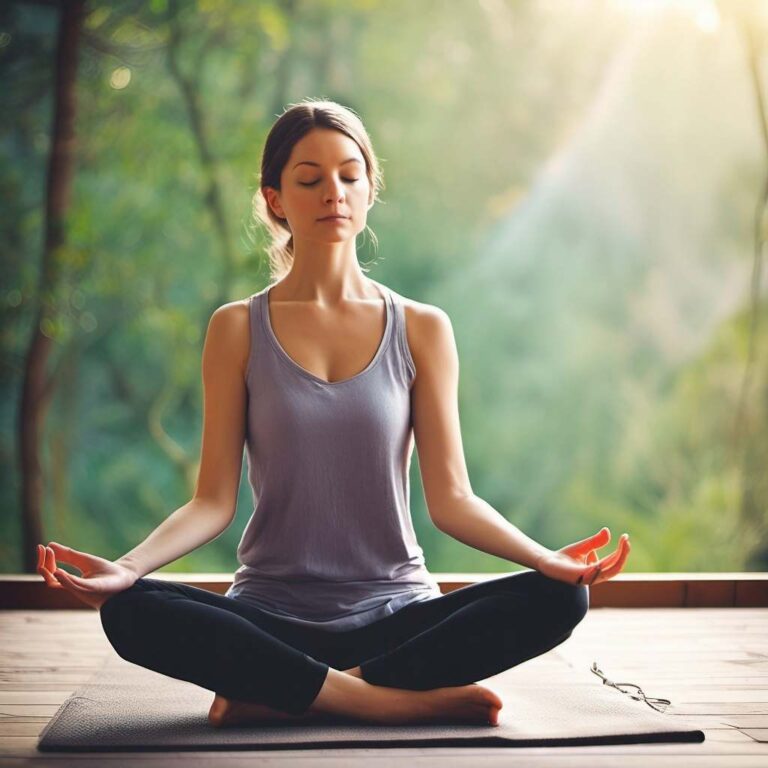Are you feeling stressed, anxious, or just need a moment of peace in your busy day? We’ve been there too and research shows that meditation might be the solution for us. In this blog post, we’ll guide you through understanding what meditation is and how to meditate, offering simple strategies and step-by-step techniques suited for everyone.
How to Meditate – Stop your Mind from Wandering
- Key Takeaways
- Benefits of Meditation
- Different Types of Meditation
- Basic Meditation Techniques
- Guided Meditations for Beginners (1-Minute, 10-Minute, 15-Minute)
- Body Scan Meditation
- Walking Meditation
- Loving-Kindness Meditation
- Dealing with a wandering mind
- Managing expectations
- Common hurdles
- Going deeper in your practice
- Creating a routine
- Taking small steps
- Meditating with others
- Enjoying the process
- FAQs about How to Meditate
- 1. What is meditation and how does it work?
- 2. How do I start meditating as a beginner?
- 3. How long should I meditate for each session?
- 4. Can anyone meditate or is it only for certain people?
Get ready to embark on a journey towards tranquility!

Key Takeaways
- Meditation is a practice that can help reduce stress, enhance focus, and improve overall mental and physical well-being.
- There are different types of meditation techniques, such as mindfulness meditation, spiritual meditation, mantra meditation, transcendental meditation, movement meditation, love and kindness meditation, body scan or progressive relaxation.
- Basic techniques for starting a meditation practice include finding a quiet space to sit or lie down comfortably, focusing on your breath and being present in the moment. Guided meditations can be helpful for beginners.
- Taking just a few minutes each day to meditate can bring about inner peace and clarity. Consistency is key in experiencing the benefits of regular meditation practice.
What is Meditation?
Meditation is a practice used to train attention and awareness, leading to a mentally clear and emotionally calm state.
Benefits of Meditation
Understanding the benefits of meditation can serve as a great motivator to incorporate this practice into our everyday life. Here are some critical advantages that we can harness from regular meditation:
- Mental Clarity: We achieve enhanced focus and clear thinking, which promotes productivity and creativity.
- Stress Relief: Regular meditation helps in alleviating stress by promoting relaxation and calmness.
- Improved Heart Health: It’s proven that meditating can aid in reducing high blood pressure, which is beneficial for our heart health.
- Enhanced Attention Span: As pointed out earlier, consistent meditation sharpens our attention span.
- Combat Neurodegenerative Diseases: Consistent, long-term meditation may slow down or even prevent certain neurodegenerative diseases.
- Better Emotional Health: Engaging in daily mindfulness meditations leads to increased positivity and reduced negativity, enhancing overall emotional well-being.
- Respiratory System Support: Believe it or not, meditation also imparts significant benefits to our respiratory system.
- Boost Happiness Levels: People who meditate generally lead happier lives than those who do not – simple yet fascinating!
- Improved Memory Recall: A surprising benefit of meditation is its positive impact on memory improvement.
- Resilience Toward Stress: By maintaining a steady routine of meditative practice, we build resilience towards stress over the long term.
- Promote Positive Emotions and Thoughts Flow: With frequent use of transcendental and mindfulness techniques during meditation, we generate an ongoing flow of constructive thoughts and emotions within ourselves.
Different Types of Meditation
There are several types of meditation techniques, each serving different purposes and offering different advantages. From focusing on your breath to cultivating compassion, every method comes with its unique benefits. Here’s a simple table to help you get a sense of the different types and how to meditate with those techniques:
| Type of Meditation | Description | Benefits |
|---|---|---|
| Mindfulness Meditation | This involves paying attention to your thoughts as they pass through your mind. You observe them without judgement. | Improves memory and sharpens attention (Fact 1, 4) |
| Spiritual Meditation | Used in eastern religions, like Hinduism, Daoism, and Christianity. It’s often done at home or at a place of worship. | Enhances the flow of constructive thoughts and positive emotions (Fact 7) |
| Mantra Meditation | Involves repeating a word or phrase silently or aloud, it’s common in many Hindu and Buddhist traditions. | Can help reduce blood pressure (Fact 3) |
| Transcendental Meditation | Is a type of mantra meditation, involves repeating a word or sound to focus your thoughts. | Increases resiliency to stress (Fact 5) |
| Movement Meditation | This form of meditation is good for those who find peace in action and prefer to let their minds wander. | Supports the lungs and benefits the respiratory system (Fact 9) |
| Love and Kindness Meditation | This method involves directing well-wishes and love towards yourself and others. | Leads to happier lives (Fact 6) |
| Body Scan or Progressive Relaxation | This method encourages people to scan their bodies for areas of tension with the aim of promoting relaxation. | Can slow down or prevent some neurodegenerative diseases (Fact 2) |
Remember, no one type is better than the others. The right meditation style for you depends on your unique needs, preferences, and goals.
How to Meditate
To begin meditating, start by finding a quiet and comfortable place to sit or lie down.
Basic Meditation Techniques
Here are some basic meditation techniques that can help you start or enhance your meditation practice:
- Find a quiet and comfortable space: Choose a spot in your home or outdoors where you can sit comfortably without distractions. Make sure the area is clean and peaceful.
- Sit in a comfortable position: You can sit cross-legged on a cushion or mat, or on a chair with your feet flat on the ground. Keep your spine straight but relaxed, and rest your hands on your lap or knees.
- Focus on your breath: Close your eyes and take a few deep breaths to relax. Then, bring your attention to your breath. Notice the sensation of each inhale and exhale as you breathe naturally.
- Be present in the moment: As thoughts arise, gently acknowledge them without judgment and let them go. Bring your focus back to the present moment by anchoring it on your breath.
- Start with short sessions: If you’re new to meditation, begin with just a few minutes each day and gradually increase the duration over time. Consistency is more important than length.
- Use guided meditations: Guided meditations are great for beginners as they provide instructions and help you stay focused. You can find many free resources online or through meditation apps.
- Try body scan meditation: This technique involves focusing on different parts of your body from head to toe, noticing any sensations or tension and letting go of any tension you may be holding onto.
- Explore walking meditation: Walking meditation is an excellent way to combine mindfulness with physical movement. Pay attention to each step, the sensation of your feet touching the ground, and the rhythm of your body in motion.
- Practice loving-kindness meditation: This type of meditation involves sending wishes of love, kindness, and compassion towards yourself and others. It helps cultivate positive emotions and empathy.
- Use deep breathing exercises: Deep breathing can help calm the mind and relax the body. Take slow, deep breaths, filling your abdomen and then your chest with air. Exhale slowly, releasing any tension.
Guided Meditations for Beginners (1-Minute, 10-Minute, 15-Minute)
If you’re new to meditation or just want a quick and easy way to relax, guided meditations can be a great place to start. These short and focused sessions provide gentle guidance and help you stay present in the moment. Whether you have one minute or 15 minutes to spare, here are some guided meditations for beginners:
- 1-Minute Meditation: Find a quiet space where you won’t be disturbed. Close your eyes and take a deep breath in, letting go of any tension as you exhale. Focus on your breath, feeling it enter and leave your body. If your mind wanders, gently bring it back to your breath. Keep breathing deeply for one minute, allowing yourself to relax and let go.
- 10-Minute Meditation: Sit comfortably with your back straight and feet flat on the floor. Close your eyes and take a few deep breaths to ground yourself. Follow along with a guided meditation app or video, focusing on your breath or a specific object of attention. Allow any thoughts or distractions to come and go without judgment, returning to the present moment each time.
- 15-Minute Body Scan Meditation: Lie down on a comfortable surface and close your eyes. Start by bringing awareness to your breath, noticing the sensation of each inhale and exhale. Slowly shift your attention throughout different parts of your body, starting from the top of your head all the way down to your toes. Notice any sensations or areas of tension, allowing them to release as you breathe into them.
- Walking Meditation: Find a peaceful outdoor location where you can walk uninterrupted for about 10-15 minutes. Begin by taking a few deep breaths and becoming aware of the physical sensations in your body as you walk. Pay attention to each step, noticing the contact between your feet and the ground. If thoughts arise, simply acknowledge them before redirecting your focus back to your walking.
Body Scan Meditation
Body scan meditation is a powerful technique that allows you to connect with your body and bring awareness to each part. It involves systematically focusing on different areas of the body, starting from the top of your head and moving down to your toes.
This practice helps you cultivate mindfulness and deepen your mind-body connection. As you scan through your body, you may notice sensations, tensions, or even areas of relaxation.
The goal is not to judge or change anything but simply observe and accept what arises without attachment. Regular body scan meditations can promote physical relaxation, reduce muscle tension, relieve stress, and enhance overall well-being.
Walking Meditation
Walking meditation is a form of mindfulness practice that combines the physical activity of walking with focused attention on the present moment. Unlike traditional seated meditation, walking meditation allows you to engage your body while also cultivating awareness and relaxation.
As you walk slowly and deliberately, paying attention to each step and the sensations in your feet, you can experience a sense of grounding and connection to the present moment. Walking meditation has been shown to reduce stress, improve focus and concentration, boost mood, and enhance overall well-being.
Plus, it’s a great way to incorporate movement into your daily meditation practice! So why not take a stroll in nature or simply walk around your neighborhood while practicing mindful walking? It’s an accessible and rejuvenating way to find peace amidst the busyness of life.
Loving-Kindness Meditation
Loving-kindness meditation is a powerful practice that cultivates feelings of love, compassion, and goodwill towards ourselves and others. By focusing on sending well-wishes to those around us, we foster a sense of connection and empathy.
Research has shown that loving-kindness meditation can increase positive emotions, reduce negative feelings like anger and anxiety, and improve relationships with others. It also strengthens our ability to empathize with the suffering of others and promotes emotional resilience.
Regularly practicing loving-kindness meditation can bring more kindness into our lives while enhancing our overall well-being.
Overcoming Challenges in Meditation
– Addressing a wandering mind is one of the biggest challenges in meditation, but with practice, we can learn to gently bring our focus back to the present moment.
Dealing with a wandering mind
One of the biggest challenges in meditation is dealing with a wandering mind. It’s completely normal for thoughts to pop into your head while you’re trying to meditate, and it can be frustrating when this happens.
But don’t worry, it’s all part of the process. Instead of fighting or suppressing these thoughts, we can simply acknowledge them and let them go. This practice of non-judgmental awareness helps us cultivate a sense of detachment from our thoughts and allows us to stay focused on the present moment.
Remember that meditation is not about emptying the mind; it’s about observing our thoughts without getting caught up in them. So if your mind starts to wander during your practice, gently guide your attention back to your breath or whatever anchor you’re using for focus.
Managing expectations
It’s important to manage our expectations when it comes to meditation. While meditation is a powerful practice with numerous benefits, it’s not a magic pill that will instantly solve all of our problems or make us completely stress-free.
It takes time and consistent effort to experience the full effects of meditation. Just as physical exercise requires regular training to build strength and endurance, meditation is an ongoing process that strengthens our mental muscles over time.
So instead of aiming for perfection or expecting instant results, focus on showing up for your meditation practice regularly and being patient with yourself. Remember that every small step you take towards stillness and self-awareness is progress in itself.
Common hurdles
We understand that starting or maintaining a meditation practice can sometimes be challenging. Here are some common hurdles you may encounter in your meditation journey:
- Restless Thoughts: It’s normal for your mind to wander during meditation. Instead of getting frustrated, gently bring your attention back to the present moment.
- Impatience: Meditation requires patience and consistency. Remember that it takes time to experience the full benefits. Stay committed and trust the process.
- Physical Discomfort: Sitting still for an extended period can lead to physical discomfort. Find a comfortable posture, use props if needed, and adjust as necessary to alleviate any discomfort.
- Time Constraints: Finding time for meditation can be difficult in our busy lives. Start with short sessions and gradually increase the duration as you build your practice.
- Lack of Discipline: Maintaining a regular meditation practice requires discipline and commitment. Set aside dedicated time each day and make it a priority.
- Self-Judgment: It’s common to judge ourselves for having “bad” or “unproductive” meditations. Remember that every session is unique, and there’s no right or wrong way to meditate.
- Inconsistency: Life can get in the way, causing inconsistency in your meditation practice. When this happens, be gentle with yourself and aim to get back on track as soon as possible.
- Expectations: Having unrealistic expectations about meditation can hinder progress. Let go of expectations and embrace each session with an open mind.
- Busy Mind: Sometimes our minds feel particularly busy or overwhelmed. During these times, remind yourself that meditation is a tool to find peace amidst the chaos.
- Distractions: External distractions like noise or interruptions can disrupt your meditation session. Minimize distractions by finding a quiet space or using earplugs/headphones.
Going deeper in your practice
As we continue to meditate and incorporate the practice into our daily lives, we may find ourselves wanting to go deeper in our meditation journey. This means exploring new techniques or deepening our understanding of existing ones.
It’s important to remember that there is no one right way to meditate, so it’s about finding what works best for us individually. Going deeper might involve seeking out guidance from experienced practitioners or attending meditation retreats where we can immerse ourselves in a more intensive practice.
By going deeper in our meditation practice, we have the opportunity to experience even greater benefits such as improved mental clarity, increased self-awareness, and enhanced emotional balance.
Making Meditation a Habit
– Creating a routine can help make meditation a daily habit.
– Start with small steps, like meditating for just a few minutes each day.
– Meditating with others can provide support and accountability.
– Remember to enjoy the process and not get too caught up in expectations.
Read on to discover more tips on how to make meditation a habit.
Creating a routine
One of the keys to successful meditation is creating a routine. By making meditation a regular part of your daily life, you can experience its full benefits and make it a lasting practice. Here are some tips for establishing a meditation routine:
- Set aside a specific time: Choose a time during the day when you can consistently dedicate to your meditation practice. It could be in the morning, before bed, or any other time that works best for you.
- Start with short sessions: When beginning your meditation journey, aim for shorter sessions, such as 5 or 10 minutes. As you become more comfortable and build endurance, gradually increase the duration of your sessions.
- Find a quiet space: Look for a quiet and peaceful place where you can meditate without distractions. It could be a designated corner in your home or even outdoors in nature.
- Create a comfortable environment: Make sure you’re comfortable during your practice. Sit on a cushion or chair that supports good posture. You may also want to use blankets or pillows for added comfort.
- Use reminders: Set reminders on your phone or place visual cues around your home to remind yourself to meditate regularly. This will help reinforce the habit and make it easier to stick to your routine.
- Be flexible: While having a set time and place for meditation is ideal, don’t be too rigid with yourself. Life can sometimes get busy, so be willing to adapt and find alternative times or locations when needed.
- Seek support: Consider joining a meditation group or finding an accountability partner who shares your interest in meditation. This can provide motivation and support as you establish and maintain your routine.
Taking small steps
When it comes to starting or maintaining a meditation practice, taking small steps can make all the difference. It’s important to remember that meditation is not something you need to master overnight.
Begin by setting aside just a few minutes each day for your practice. This could be as simple as finding a quiet and comfortable space, closing your eyes, and focusing on your breath for just one minute.
As you become more comfortable with these short sessions, gradually increase the time to 5 minutes, then 10 minutes, and so on. By taking small steps and gradually increasing the duration of your meditations, you’ll find it easier to establish a consistent habit over time.
Meditating with others
Meditating with others can be a powerful and uplifting experience. It creates a sense of unity and connection, as you are sharing the same intention and energy with those around you.
When we meditate in a group, the collective energy amplifies the benefits of meditation, allowing for deeper relaxation, focus, and stress relief. Research has shown that group meditation can even have social and emotional benefits, such as increased empathy and compassion towards others.
So whether it’s joining a local meditation group or participating in virtual meditation sessions online, meditating with others can enhance your practice and foster a greater sense of community and wellbeing.
Enjoying the process
As we embark on our meditation journey, it’s important to remember that enjoying the process is key. Meditation is not about striving for perfection or achieving a specific goal; instead, it’s about embracing the present moment and finding joy in the practice itself.
Whether you’re just starting out or have been meditating for years, every session offers an opportunity to explore and deepen your connection with yourself.
By approaching meditation with curiosity and an open mind, you can discover new insights and experiences along the way. Embrace the gentle rhythm of your breath, appreciate the stillness within you, and savor each precious moment of calmness and tranquility.
Allow yourself to let go of any expectations or judgments as you engage in this mindful activity.
Remember that meditation is a personal journey, so there’s no right or wrong way to do it. Trust your intuition and find techniques that resonate with you. It could be focused breathing exercises, guided meditations, body scans, or even walking meditations – whatever brings you a sense of peace and presence.
FAQs about How to Meditate
We understand that starting a meditation practice can come with many questions. Here are some common FAQs about meditation:
1. Is it okay if my mind wanders during meditation?
Yes, it’s completely normal for your mind to wander during meditation. The key is to gently bring your focus back to the present moment without judgment.
2. How long should I meditate?
There’s no set time for how long you should meditate. Start with just a few minutes and gradually increase the duration as you become more comfortable.
3. Can I meditate while lying down?
While it’s usually recommended to sit in a comfortable position during meditation, you can also meditate while lying down if that works best for you.
4. Do I need special equipment or clothing to meditate?
No, you don’t need any special equipment or clothing to meditate. Just find a quiet space where you feel comfortable and can relax.
5. What if I fall asleep during meditation?
Falling asleep is not uncommon, especially when starting out. If you find yourself consistently falling asleep, try sitting up straighter or experimenting with different times of the day to meditate.
Remember, there’s no right or wrong way to meditate – it’s all about finding what works best for you and staying consistent with your practice.
Conclusion
In conclusion, meditation is a powerful tool for improving our overall mental and physical wellbeing. By incorporating mindfulness practices into our daily lives, we can reduce stress, increase self-awareness, and enhance focus and relaxation.
Whether you’re a beginner or an experienced practitioner, taking small steps towards making meditation a habit will bring profound benefits to your life. So start today by finding a quiet space, focusing on your breath, and allowing yourself to be fully present in the moment.
Remember that with patience and consistency you will find your way of how to meditate, you can unlock the transformative power of meditation in your own life.
General FAQs
1. What is meditation and how does it work?
Meditation is a practice that involves training the mind to focus and redirect thoughts. It typically involves sitting in a quiet space, closing the eyes, and focusing on the breath or a specific object. Through regular practice, meditation can help reduce stress, improve mental clarity, and increase feelings of calmness.
2. How do I start meditating as a beginner?
To start meditating as a beginner, find a quiet and comfortable space where you won’t be disturbed. Sit in a relaxed position with your spine straight and close your eyes. Begin by focusing on your breath, taking slow inhales and exhales. If your mind starts to wander, gently bring your attention back to the breath without judgment.
3. How long should I meditate for each session?
The duration of each meditation session can vary depending on personal preference and availability of time. For beginners, starting with just 5-10 minutes per day can be beneficial. As you become more comfortable with the practice, gradually increase the duration to 20-30 minutes or longer if desired.
4. Can anyone meditate or is it only for certain people?
Anyone can meditate regardless of age or background. Meditation is not limited to specific individuals but rather accessible to everyone who wishes to cultivate mindfulness and inner peace. Whether you are new to meditation or have been practicing for years, anyone can benefit from incorporating this technique into their daily routine.





